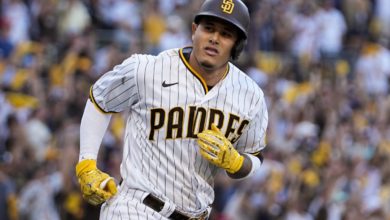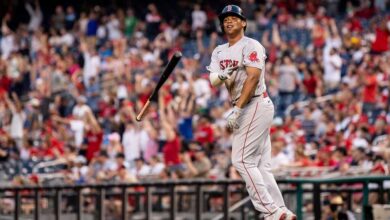San Diego Padres (2010 record: 90-72)
Notable additions: SS Jason Bartlett, 1B Jorge Cantu, RHP Aaron Harang, 1B Brad Hawpe, 2B Orlando Hudson, CF Cameron Maybin, SP Dustin Moseley, C Gregg Zaun
Notable subtractions: 2B David Eckstein, RHP Jon Garland, 1B Adrian Gonzalez, CF Tony Gwynn Jr., SS Miguel Tejada, C Yorvit Torrealba, RHP Chris Young
IMO, there is very little chance the Padres repeat their surprising performance of 2010. The club lost three-quarters of its starting infield, its center fielder, one of its catchers, and one of its best starting pitchers. In each instance, the replacement player was a significant downgrade, except at second base (Hudson in place of Eckstein). It is pretty safe to say that the club has thrown itself headlong into re-building mode.
The offense:
C: Nick Hundley
INF: Brad Hawpe (1B), Orlando Hudson (2B), Jason Bartlett (SS) and Chase Headley (3B)
OF: Ryan Ludwick (LF), Cameron Maybin (CF) and Wil Venable (RF)
Gonzalez had another outstanding season, yet at the end of the year it became obvious the organization would not be able to sign him. So he was shipped to Boston in exchange for 3 of the Red Sox Top 6 prospects (including No. 1 prospect Casey Kelly). But he wasn’t the only player to find a new home, as three-quarters of the infield was turned over.
The impact of the loss of 1B Adrian Gonzalez is incalculable, especially when you consider he has been replaced by Hawpe (.245, 9 HR, 44 RBI). The additions of Hudson and Bartlett in the middle infield will do little (or nothing) to help offset A-Gon’s loss – as both are getting long in the tooth. Hudson’s skills are clearly diminishing with age. As for Bartlett, his numbers with Tampa last year were pretty dismal by his standards, although his sub-standard performance can be explained (in part) by his 30% hit-rate. Headley was supposed to provide power and production when he arrived in San Diego, but Petco Park seems to have sapped some of the pop in his bat (though his splits illustrate he struggles on the road, too, and that he is not getting the ball in the air often enough to take advantage of his power).
In the outfield, Ludwick’s production back in 2008 has proven to be an outlier… his productivity diminished in each of the last two seasons and, at 32 years of age, it is clear his better days are in the rear view window. Maybin has shown tremendous potential in the minor leagues, but his contact rate and on-base skills in the big leagues have prevented him from taking full advantage of his elite speed. As for Venable, he should be considerably better in 2011. Last year he had a dismal contact rate (67%, well below his career mark). Looking ahead it seems likely it will return to the low-to-mid-70s, raising his average considerably. If he is able to get on base more consistently, his speed could allow him to develop into a 40-to-50 steals guy.
The pitching staff:
The pitching staff will likely take a considerable step backwards in 2011. The exchange of innings-eater Garland for the increasingly injured (and ineffective) Harang will have a significant adverse impact on the club in 2011… it is a trade-off that will result in (at least) a half-dozen fewer wins in 2011. Mat Latos showed tremendous growth last year, especially in terms of his DOM and ground ball rate, but his increased workload suggest a regression, or injury risk, is in the offing for 2011. LHP Clayton Richard had a great first half last season, but struggled throughout the second half. It remains to be seen whether he is the solid pitcher the Padres saw in the first half or the guy who posted a 4.78 ERA in the second half. The 5th spot in the rotation will likely go to former 1st-round pick Tim Stauffer, a ground ball pitcher who has demonstrated the ability to strike out enough hitters to be effective in the major leagues.
The bullpen has a bevy of solid arms. Heath Bell is among the best closers in all of baseball. Luke Gregerson (89 K in 78 IP), Mike Adams (73 K in 66 IP), Joe Thatcher (45 K in 35 IP) and Ernesto Frieri (41 K in 31 IP) provide manager Bud Black a bevy of strong-armed options out of the bullpen to bridge the gap between the starting rotation and Bell.
Prediction for 2011: 4th place, 77-85
It’s likely the team will have offensive deficiencies it will not be able to overcome. The team ranked 12th (of 16) in the NL in runs scored last year and then lost its most productive hitter. Only two of the team’s returning regulars had as many as 50 RBI.
The pitching will HAVE to be good for the team to perform any better than this projection, but it seems unlikely the staff can come close to accomplishing what it did last season. The data suggests the team should be wary of counting too heavily on Latos – they have increased his innings pitched by 60+ in each of the last two seasons. For pitchers under 25 years of age that type of increase has the potential to be disastrous. If he should struggle or suffer an injury, 70 wins becomes more likely than 80 wins.
——————————————–
Top Five Prospects:
1. Casey Kelly, RHP
2. Simon Castro, RHP
3. Anthony Rizzo, 1B
4. Donavan Tate, OF
5. Cory Luebke, LHP
Casey Kelly was selected by the Red Sox with the 30th overall pick in the 2008 draft… the Sox lured him away from a Tennessee football scholarship with a three million dollar signing bonus. He had stated a preference to play the infield (shortstop) rather than pitch, so the Red Sox agreed to give him ONE year in the field before asking him to make a final decision. In 2009, the organization allowed Kelly to spend the first half of the season pitching, with the concession he could play shortstop in the second half. While he showed impressive defensive ability at short, his superb performance as a starting pitcher warranted a permanent position change.
He was selected to pitch in the MLB Futures Game and was later named the Red Sox Minor League Pitcher of the Year… the choice was made – he would pitch.
He is a well-rounded pitcher who has three “plus” pitches, all of which he throws for strikes. He has a low-90s fastball that scouts score as a “65″ on the “20 – 80″ scale. His off-speed pitches make him a top-tier prospect. He has quick action arm and a consistent delivery that makes his changeup difficult to recognize. It is his out pitch… he uses it to rack up groundouts. Kelly also has an 11-to-5 curveball that has “swing and miss” potential.






